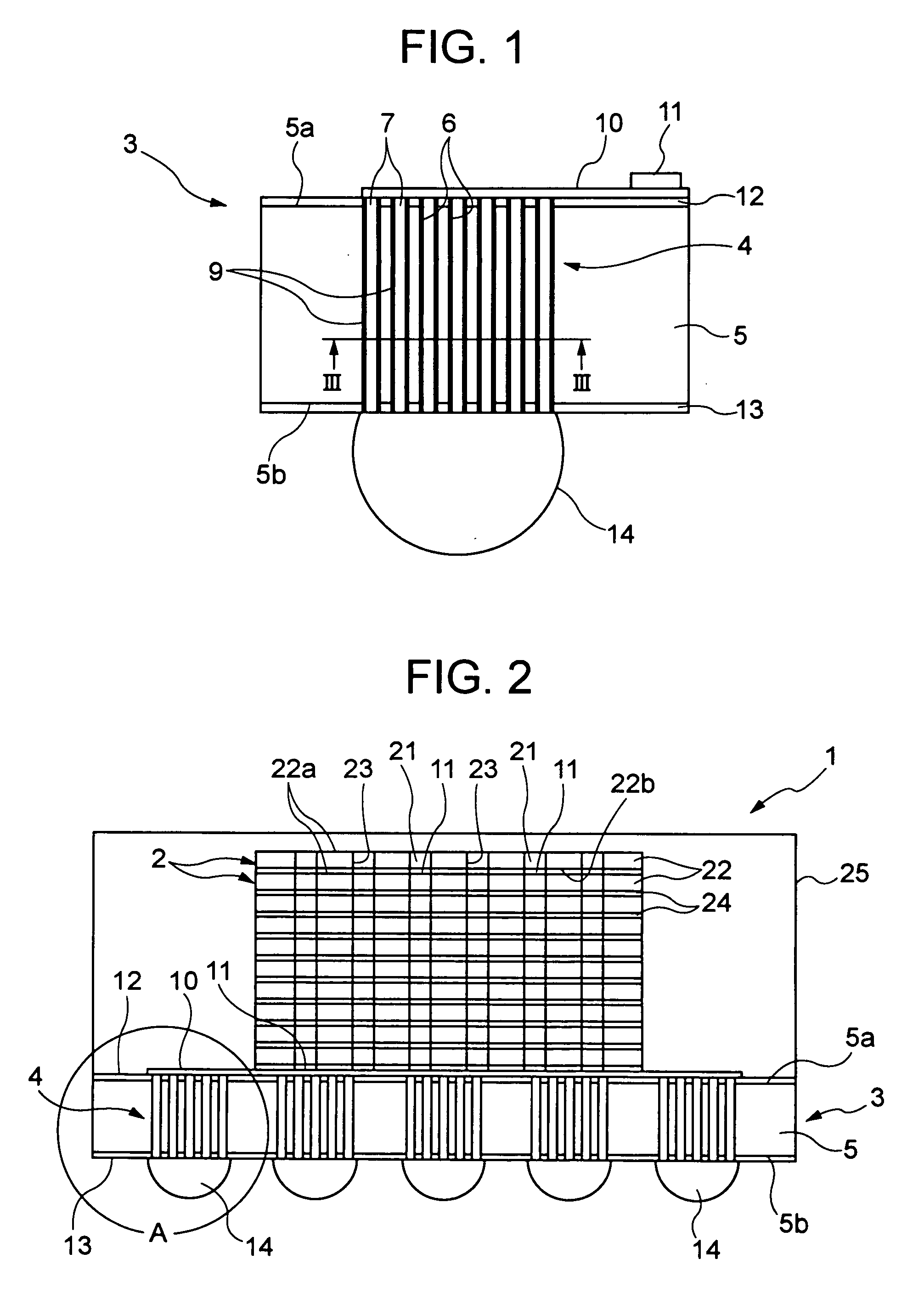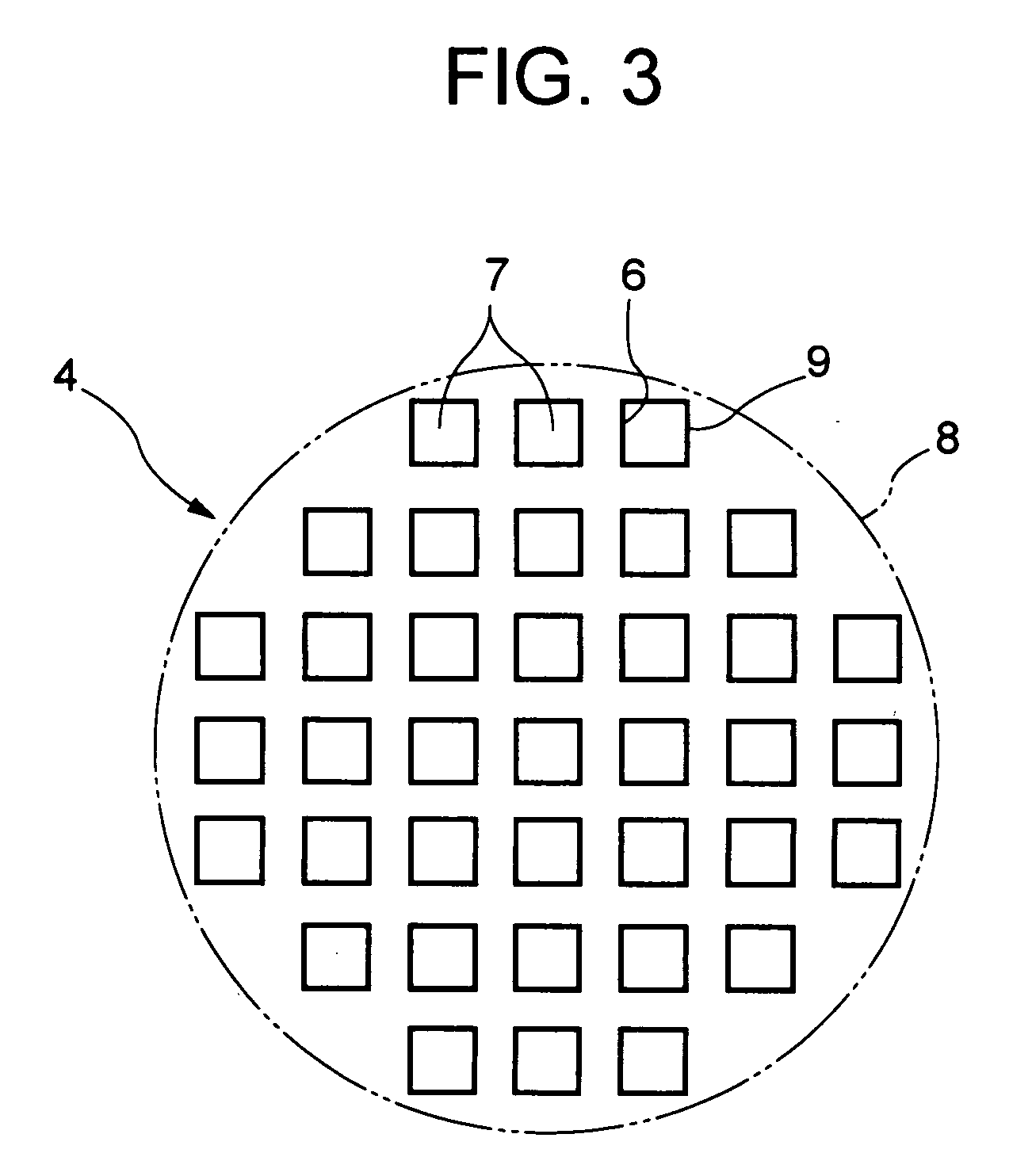Through electrode, package base having through electrode, and semiconductor chip having through electrode
- Summary
- Abstract
- Description
- Claims
- Application Information
AI Technical Summary
Benefits of technology
Problems solved by technology
Method used
Image
Examples
first embodiment
[0045] Referring to FIG. 1 to FIG. 3, a through electrode and a method of making the through electrode according to a first embodiment will be described. FIG. 1 is an enlarged view of part A in FIG. 2.
[0046] Referring to FIG. 2, a semiconductor package 1 includes a plurality of semiconductor chips 2 stacked one on another on a package base 3.
[0047] In FIG. 2, a plurality of through electrode units 4 are provided in the package base 3. Each through electrode unit 4 includes a plurality of slender conductive bodies 7 made of copper or silver. The conductive bodies 7 are embedded in a plurality of slender through holes 6 formed through a silicon substrate (i.e., base substrate) 5 of the package base 3 from the upper surface 5a to the lower surface 5b of the base substrate 5, respectively. The through electrode units 4 establish electrical conduction between the upper surface 5a and the lower surface 5b of the base substrate 5.
[0048] The through holes 6 have a square cross-sectional ...
second embodiment
[0084]FIG. 5 is a partial sectional view illustrating a package base according to a second embodiment of the present invention, and FIG. 6 is a cross-sectional view taken along line VI-VI in FIG. 5.
[0085] Components of the package base in the second embodiment, which are identical to those of the package base in the first embodiment, are indicated by the same reference numerals as the first embodiment, and a description thereof will not be given.
[0086] Referring to FIGS. 5 and 6, an electrode unit through hole 31 has the same dimension as the electrode forming area 8. In the electrode unit through hole 31 are disposed a plurality of silicon columns 32. Each silicon column 32 has a square sectional shape having a width of 5 to 30 μm or a circular sectional shape having a diameter of 5 to 30 μm. The electrode unit through hole 31 except for the silicon columns 32 is filled with a conductive body 7 to form a lotus root-shaped through electrode unit 4. In FIGS. 5 and 6, insulating fil...
third embodiment
[0101]FIG. 8 is a partial sectional view illustrating a package base according to a third embodiment of the present invention.
[0102] Components of the package base according to the third embodiment, which are identical to those of the package base according to the first embodiment, are indicated by the same reference numerals as those of the package base according to the first embodiment, and a description thereof will not be given.
[0103] A through electrode unit 4 in the third embodiment is the same as the through electrode unit in the first embodiment.
[0104] Referring to FIG. 8, a pad 35 made of copper or nickel and gold is formed in the through electrode forming area 8 such that the lower ends of a plurality of conductive bodies 7 of the through electrode unit 4 are joined with each other by the pad 35. In FIG. 8, insulating films 9 are shown by a solid bold line.
[0105] Now, the package base manufacturing method according to the third embodiment of the present invention will ...
PUM
 Login to View More
Login to View More Abstract
Description
Claims
Application Information
 Login to View More
Login to View More - R&D
- Intellectual Property
- Life Sciences
- Materials
- Tech Scout
- Unparalleled Data Quality
- Higher Quality Content
- 60% Fewer Hallucinations
Browse by: Latest US Patents, China's latest patents, Technical Efficacy Thesaurus, Application Domain, Technology Topic, Popular Technical Reports.
© 2025 PatSnap. All rights reserved.Legal|Privacy policy|Modern Slavery Act Transparency Statement|Sitemap|About US| Contact US: help@patsnap.com



